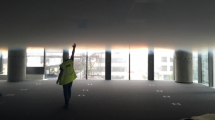Abstract
Enclosure smoke filling and management are addressed from the standpoint of the volumetric flow rates commonly used for mechanical ventilation system design. In this context, fire-induced gas expansion is treated as a volumetric source term. A two-layer analysis developed previously for enclosure smoke filling without mechanical ventilation is extended to consider the impact of mechanical ventilation on smoke layer descent rates and conditions within the smoke layer. A spreadsheet-based model of enclosure smoke filling developed in conjunction with the previous unventilated analysis is also extended to consider both mechanical extraction and injection systems. Some implications of mechanical ventilation on the development and descent of a smoke layer in an enclosure fire are discussed.
Similar content being viewed by others
References
L.Y. Cooper, “A Mathematical Model for Estimating Available Safe Egress Time from Fires,” Fire and Materials, vol. 6, 1982, pp. 135–143.
NFPA, Guide for Smoke Management Systems in Malls, Atria, and Large Areas, NFPA 92B-1995, Quincy, MA: National Fire Protection Association, 1995.
BSI, “Fire Safety Engineering in Buildings. Part 1. Guide to the Application of Fire Safety Engineering Principles” DD240: Part 1: 1997, London: British Standards Institute, 1997.
Fire Code Reform Centre Limited, Fire Engineering Guidelines, Sydney, 1996.
J.A. Milke, and F.W. Mowrer, “An Algorithm for the Design Analysis of Atrium Smoke Management Systems,” FP93-04, University of Maryland at College Park: Department of Fire Protection Engineering, 1993.
E.E. Zukoski, “Development of a Stratified Ceiling Layer in the Early Stages of a Closedroom Fire,” Fire and Materials, vol. 2, 1978, pp. 54–62.
W.D. Walton, “ASET-B: A Room Fire Program for Personal Computers,” Fire Technology, vol. 21, 1985, pp. 293–309.
H.E. Nelson, “FPETOOL: Fire Protection Engineering Tools for Hazard Estimation,” NISTIR 4380, National Institute of Standards and Technology, Gaithersburg, MD, General Services Administration, Washington, DC, October 1990, 120 p.
R.W. Portier, R.D. Peacock, and P.A. Reneke, “FASTLite: Engineering Toolsfor Estimating Fire Growth and Smoke Transport,” NIST SP 899, Gaithersburg, MD: National Institute of Standardsand Technology, 1996.
F.W. Mowrer, “Enclosure Smoke Filling Revisited,” Fire Safety Journal, vol. 33, 1999, pp. 93–114.
F.W. Mowrer, “Methods of Quantitative Fire Hazard Analysis,” TR-100443, Palo Alto, CA: Electric Power Research Institute, May 1992 (reprinted by the Society of Fire Protection Engineers with permission from EPRI).
L.Y. Cooper, “Compartment Fire-Generated Environment and Smoke Filling,” in SFPE Handbook of Fire Protection Engineering, 2nd ed., P.J. DiNenno, Ed. Quincy, MA: National Fire Protection Association, 1993.
A. Tewarson, “Generation of Heat and Chemical Compounds in Fire,” in SFPE Handbook of Fire Protection Engineering, 2nd ed., P.J. DiNenno, Ed. Quincy, MA: National Fire Protection Association, 1993.
H.W. Emmons, “Vent Flows,” in SFPE Handbook of Fire Protection Engineering, 2nd ed., P.J. DiNenno, Ed. Quincy, MA: National Fire Protection Association, 1993.
J.H. Klote, and J.A. Milke, Design of Smoke Management Systems, Atlanta, GA: American Society of Heating, Refrigerating and Air-Conditioning Engineers, Inc., 1992.
V. Ho, N. Siu, and G. Apostolakis, “COMPBRN III—A Fire Hazard Model for Risk Analysis,” Fire Safety Journal, vol. 13, 1988, pp. 137–154.
K.L. Foote, P.J. Pagni, and N.J. Alvares, “Temperature Correlations for Forced-Ventilation Compartment Fires,” in Fire Safety Science—Proceedings of the First International Symposium, 1986.
C. Beyler, “Analysisof Compartment Fireswith Overhead Forced Ventilation,” in Fire Safety Science—Proceedings of the Third International Symposium, 1991.
C.L. Beyler, “Major SpeciesProduction by Diffusion Flamesin a Two-layer Compartment Environment,” Fire Safety Journal, vol. 10, 1986, pp. 47–56.
D.T. Gottuk and R.J Roby, “Effectsof Combustion Conditionson SpeciesProduction, ” in SFPE Handbook of Fire Protection Engineering, 2nd ed., P.J. DiNenno, Ed. Quincy, MA: National Fire Protection Association, 1993.
C. Huggett, “Estimation of Rate of Heat Release by Means of Oxygen Consumption Measurements,” Fire and Materials, vol. 6, 1980, pp. 61–65.
M. Janssens, “Calorimetry,” in SFPE Handbook of Fire Protection Engineering, 2nd ed., P.J. DiNenno, Ed. Quincy, MA: National Fire Protection Association, 1993.
E.E. Zukoski, S.J. Toner, J.H. Morehart, and T. Kubota, “Combustion Processes in Two-Layered Configurations,” in Fire Safety Science—Proceedings of the Second International Symposium, 1988, pp. 295–304.
J.H. Morehart, E.E. Zukoski, and T. Kubota, “Characteristics of Large Diffusion Flames Burning in a Vitiated Atmosphere,” in Fire Safety Science—Proceedings of the Third International Symposium, 1991, pp. 575–583.
E.E. Zukoski, T. Kubota, and B. Cetegen, “Entrainment in Fire Plumes,” Fire Safety Journal, vol. 3, 1980/81, pp. 107–121.
C.L. Beyler, “'Fire Plumesand Ceiling Jets,” Fire Safety Journal, vol. 11, no.53, 1986, pp. 53–75.
J.G. Quintiere, and B.S. Grove, “Correlationsfor Fire Plumes,” NIST GCR 98-744, National Institute of Standards and Technology, Gaithersburg, MD, 1998, 207 p.
P.S. Ziesler, F.S. Gunnerson, and S.K. Williams, “Advances in Positive Pressure Ventilation: Live Fire Tests and Laboratory Simulation” Fire Technology, vol. 30, no.2, 1994, pp. 269–277.
S.P. Nowlen, “Enclosure Environment Characterization Testing for the Base Line Validation of Compute Fire Simulation Codes,” NUREGCR-5681, SAND86-1296, Albuquerque, NM: Sandia National Laboratories, 1987.
Professional Loss Control, “Fire Induced Vulnerability Evaluation (FIVE),” TR-100370, Palo Alto, CA: Electric Power Research Institute, April 1992.
F.W. Mowrer, and B. Gautier, “Comparison of Fire Model Features and Computations,” in 14thP ost-SMIRT Conference Proceedings, Lyons, France, 1997.
R. Alpert and E. Ward, “Evaluation of Unsprinklered Fire Hazards,” Fire Safefy Journal, vol. 7, 1984, pp. 127–143.
M.A. Delichatsios, “The Flow of Fire Gases Under a Beamed Ceiling,” Combustion and Flame, vol. 43, no.1, 1981.
Author information
Authors and Affiliations
Rights and permissions
About this article
Cite this article
Mowrer, F.W. Enclosure Smoke Filling and Management with Mechanical Ventilation. Fire Technology 38, 33–56 (2002). https://doi.org/10.1023/A:1013476730932
Issue Date:
DOI: https://doi.org/10.1023/A:1013476730932




